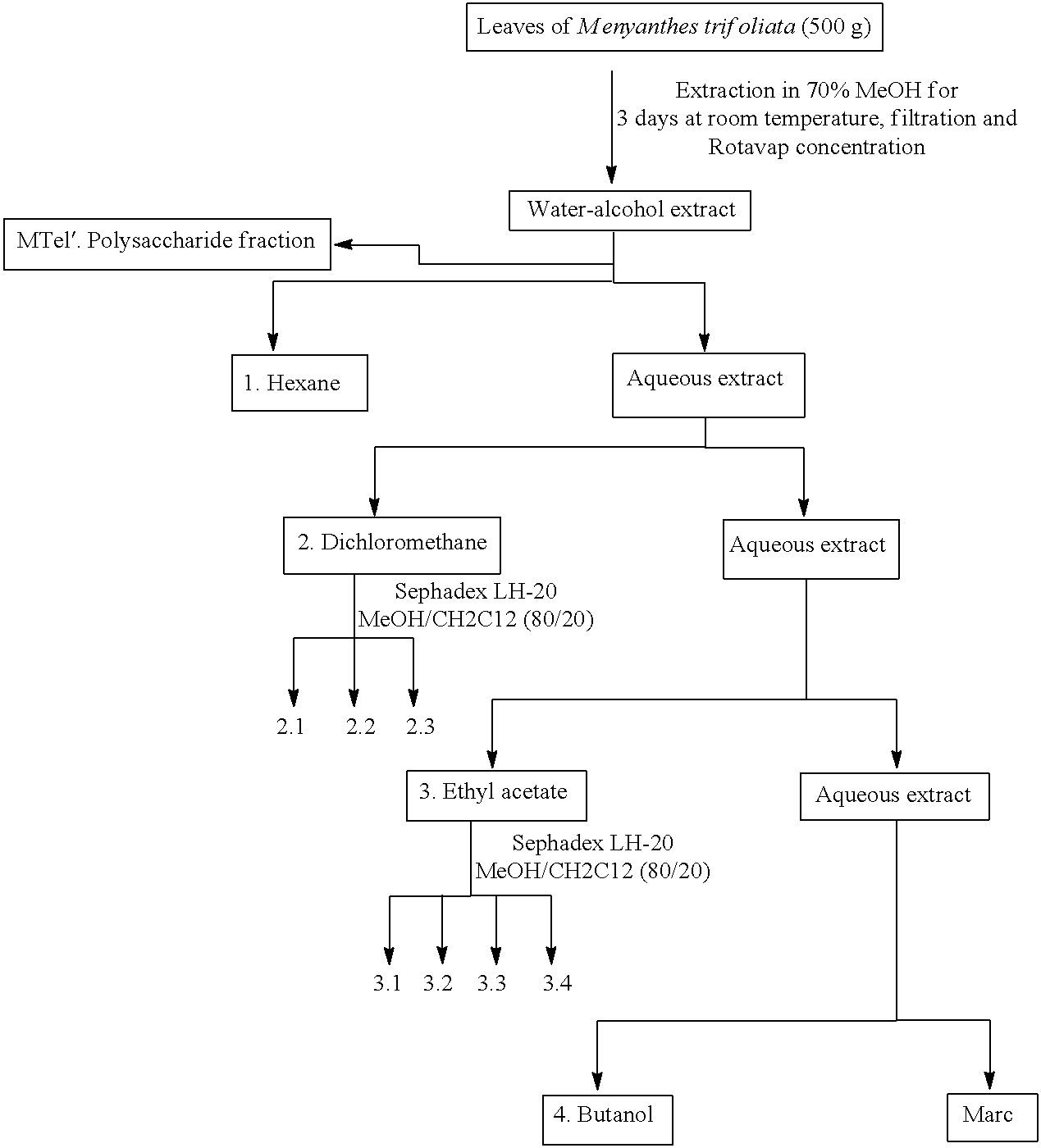Anti-Aging Compositions Comprising Menyanthes Trifoliata Leaf Extracts And Methods Of Use Thereof
a technology of compositions and extracts, applied in the field of anti-aging skin care compositions and methods, can solve the problems of pathological production of reactive oxygen species, oxidative stress, and impair cell function
- Summary
- Abstract
- Description
- Claims
- Application Information
AI Technical Summary
Benefits of technology
Problems solved by technology
Method used
Image
Examples
example 1
An Extraction Scheme for Menyanthes trifoliata Leaf Extracts
[0041]The following extraction scheme was useful in researching the properties of Menyanthes trifoliata leaf extracts. In the first step, an alcoholic solvent was applied to the dried leaves. Thereafter, the polarity of the solvents increases from the least polar, hexane to dichloromethane to ethyl acetate to the most polar, butanol. Ultimately, the components responsible for MMP-1, 2 and 9 inhibition reside in the alcoholic extract. However, additional extractions, as described below, were performed to further isolate the effective components. Some of those extracts (specifically, ethyl acetate and dichloromethane) were found to have suitable levels of the effective components. Thus, a number of solvents may be used to obtain Menyanthes trifoliata leaf extracts that inhibit MMPs-1, 2 and 9. Any of these extracts (alcoholic, ethyl acetate or dichloromethane) are suitable for compositions and methods of the present invention...
example 2
In Vitro Inhibition of MMPs by Menyanthes trifoliata Leaf Extracts
[0042]Several extracts and sub-fractions from the leaves of Menyanthes trifoliata were prepared by liquid-liquid partitioning and fractionation on a Sephadex LH20 gel filtration column (see example 1) and evaluated for specific anti-MMP activity. In vitro specific inhibition of MMP-2 and MMP-9 activity was estimated with assay kits from Biomol®. Recombinant human MMP-1 enzyme may be obtained from any commercially available source. In table 1, MMP inhibition is expressed as IC50 values, that is, the concentration of extract that results in a 50% reduction of the measured signal. Therefore, a lower value indicates a stronger MMP inhibition.
TABLE 1inhibition expressed as IC50 (μg / ml) againstMenyanthestrifoliata extractMMP-1MMP-2MMP-9MTe1′. Polysaccharides2402402401. Hexane115142882. Dichloromethane50§§3. Ethyl acetate5024834. Butanol§10194§: no activity measured
[0043]As seen from Table 1 above, the highest level of activ...
example 3
[0045]In order to determine the components responsible for the inhibition activity of the ethyl acetate and dichloromethane extracts, an HPLC compositional analysis of the extracts was performed. Table 3 shows amount of a component as a percent of the subfraction analyzed, on a weight basis. As can be seen in Table 3, phenolic acids, flavonoids and coumarins are the primary active components in ethyl acetate and dichloromethane extracts of Menyanthes trifoliata. Comparing tables 2 and 3, it is concluded that fractions with no or relatively low concentrations of phenolic acids, flavonoids and coumarins (fractions 2.1, 2.2 and 3.1), exhibit no or relatively poor MMP-1, 2, 9 inhibition activity. Conversely, those fractions with at least two of phenolic acids, flavonoids and coumarins exhibit significant inhibition activity.
TABLE 3FRACTIONSClassComponent22.12.22.333.13.23.33.4Phenolic acidsprotocate-chuic acid***0.4*0.40.3p-hydroxy******0.9**benzoic acidferulic acid***1.6*****Flavonoids...
PUM
| Property | Measurement | Unit |
|---|---|---|
| weight | aaaaa | aaaaa |
| water soluble | aaaaa | aaaaa |
| corrosive | aaaaa | aaaaa |
Abstract
Description
Claims
Application Information
 Login to View More
Login to View More - R&D
- Intellectual Property
- Life Sciences
- Materials
- Tech Scout
- Unparalleled Data Quality
- Higher Quality Content
- 60% Fewer Hallucinations
Browse by: Latest US Patents, China's latest patents, Technical Efficacy Thesaurus, Application Domain, Technology Topic, Popular Technical Reports.
© 2025 PatSnap. All rights reserved.Legal|Privacy policy|Modern Slavery Act Transparency Statement|Sitemap|About US| Contact US: help@patsnap.com

